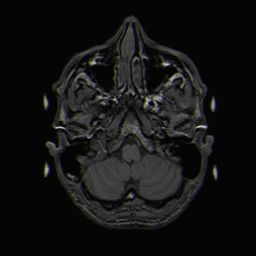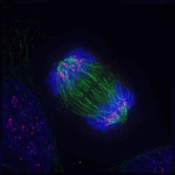Difference between revisions of "Autism Spectrum Disorders"
(→'''Genetics''') |
|||
| (154 intermediate revisions by 5 users not shown) | |||
| Line 1: | Line 1: | ||
| − | + | =='''Autism Spectrum Disorders'''<div style="float:right;padding:5px; background:green; border:2px solid black;">CNP LEVEL: Syndrome</div><br><br><br>== | |
| − | == '''Autism Spectrum Disorders''' == | + | |
| + | <font color="purple" size="4">Click</font> on the Images below to learn about research findings in ASD<br><br><br> | ||
| + | [[File:Brain_MRI_T1_movie.gif|100px|link=Neuroimaging|Neuroimaging]] Neuroimaging | ||
| + | [[Image:Anaphase_IF.gif|100px|link=Genetics|Genetics]] Genetics | ||
| + | [[Image:Human_genome.png|100px|link=Causes|Causes]] Causes | ||
| + | [[Image:Flores.gif|100px|link=Treatments|Treatments]] Treatment | ||
=== Basic Characteristics === | === Basic Characteristics === | ||
*'''Description''' | *'''Description''' | ||
| − | Autism Spectrum Disorders is a clinical description of the developmental disorders which are characterized by impaired language development, social development, and learning. | + | Autism Spectrum Disorders is a clinical description of the developmental disorders which are characterized by impaired language development, social development, and learning. According to NIMH estimates, 3.4 out of every 1000 children between 3-10 years of age have one of the disorders in the spectrum. |
They include: | They include: | ||
| − | #[[Autism]] | + | |
| − | #[[PDD-NOS]] | + | #'''[[Autism]]''' |
| − | #[[Asperger's Syndrome]] | + | #'''[[PDD-NOS]]''' |
| − | #[[Rett Syndrome]] | + | #'''[[Asperger's Syndrome]]''' |
| − | #[[Childhood Disintegrative Disorder]] | + | #'''[[Rett Syndrome]]''' |
| + | #'''[[Childhood Disintegrative Disorder]]''' | ||
Children with ASD have extremely delayed development. Symptoms of this disorder usually start to appear between 12 to 36 months and consist of not reaching normal development benchmarks such as babbling by 12 months, speaking by 16 months, or a gradual loss of language or social skills. All children with ASD show deficits in social interactions, verbal and nonverbal communication. They may also show repetitive behaviors and interests, or aggressive behavior. | Children with ASD have extremely delayed development. Symptoms of this disorder usually start to appear between 12 to 36 months and consist of not reaching normal development benchmarks such as babbling by 12 months, speaking by 16 months, or a gradual loss of language or social skills. All children with ASD show deficits in social interactions, verbal and nonverbal communication. They may also show repetitive behaviors and interests, or aggressive behavior. | ||
| − | + | Three common patterns seen in the emergence of autistic symptoms are 1) early manifestation of symptoms, 2) almost normal development, then sudden loss of previously attained social, communicative, or motor skills, or 3) mild delays until approximately 2 years of age, followed by a developmental halt. Children with ASD who show early manifestation of symptoms do not necessarily have a worse outcome of the three subsets. Those who follow a pattern of regression appear to exhibit less autistic symptoms prior to onset of regression and worse outcomes afterward as compared to the children who follow the other two patterns of development. <sup>15</sup> | |
| − | + | See [[:Category:Core Deficits]] | |
| − | + | ||
| − | + | ||
| − | + | ||
*'''History''' | *'''History''' | ||
| Line 25: | Line 28: | ||
Prior to the 1970's, many people thought Autism Spectrum Disorders were a result of psychological causes, such as having an aloof mothering style. However, during the 1980's people began to note that chromosomal disorders and rare syndromes often co-occurred with ASD. As a result, people began to suspect that ASD could have genetic underpinnings. These suspicions were confirmed when, after the development of the [[ADI-R]] and [[ADOS]] as diagnostic tools and other technical advances, the first candidate gene association and resequencing studies, followed by whole-genome linking studies were done in the late 1990's. These studies were used to identify loci of potential interest. | Prior to the 1970's, many people thought Autism Spectrum Disorders were a result of psychological causes, such as having an aloof mothering style. However, during the 1980's people began to note that chromosomal disorders and rare syndromes often co-occurred with ASD. As a result, people began to suspect that ASD could have genetic underpinnings. These suspicions were confirmed when, after the development of the [[ADI-R]] and [[ADOS]] as diagnostic tools and other technical advances, the first candidate gene association and resequencing studies, followed by whole-genome linking studies were done in the late 1990's. These studies were used to identify loci of potential interest. | ||
| − | |||
| − | |||
| − | |||
| − | |||
| − | |||
| − | === | + | ==== External Resources ==== |
| − | + | ||
| − | + | ||
| − | *[[ | + | * Links out: |
| − | *[ | + | **[http://www.google.com/search?hl=en&q=autism+spectrum+disorder&btnG=Google+Search&aq=0&oq=autism+spectru Google: Autism Spectrum Disorder] |
| + | **[http://en.wikipedia.org/wiki/Autism_spectrum Wikipedia: Autism Spectrum] | ||
| + | **[http://www.ncbi.nlm.nih.gov/sites/entrez PubMed: Autism Spectrum Disorders] | ||
| + | **-ucla cognitive atlas- (coming soon!) | ||
| − | + | * Database links | |
| + | ====Citations==== | ||
| + | 1. Keysers, Christian and Valeria Gazzola. Integrating simulation and theory of mind: from self to social cognition. ''Trends in Cognitive Sciences''. Vol 11:5 pg. 194-6; 2007 PMID 17344090 | ||
| − | + | 2. Bookheimer, S.Y. et. al. Frontal contributions to face processing differences in autism: Eviedence from fMRI of inverted face processing. "Journal of the International Neuropsychological Society". Cambridge University Press:14:922-32;2008 PMID 18954473 | |
| − | + | 3. Uddin et. al. Neural Basis of Self and Other Representation in Autism: An fMRI Study of Self-Face Recognition. ''PLoS ONE. 2008;3(10):e3526. Epub 2008 Oct 29'' PMID 18958161 | |
| − | + | ||
| − | + | 4. Jones, J.R. et. al. Hypothesis: Dysregulation of Methylation of Brain-Expressed Genes on the X Chromosome and Autism Spectrum Disorders. ''American Journal of Medical Genetics Part A'' 146A:2213-2220 (2008). PMID 18698615 | |
| − | + | ||
| − | + | 5. Lush, Molly et. al. Current Developments in the Genetics of Autism: From Phenome to Genome. ''J Neuropathol Exp Neurol. 2008 September; 67(9):829-837. PMID 18716561 | |
| − | + | 6. Arking DE et. al. A common genetic variant in the neurexin superfamily member CNTNAP2 increases familial risk of autism. Am J Hum Genet 2008;82:160-64. PMID 18179894 | |
| − | + | ||
| − | + | 7. Cook, E.H. and S. W. Scherer. Copy-number variations associated wtih neuropsychiatric conditions. Nature.2008 October;455(16) 919-23. PMID 18923514 | |
| − | + | ||
| − | + | 8. Gilbert, S.J. et. al. Abnormal functional specialization within medial prefrontal cortex in high-functioning autism: a multi-voxel similarity analysis. ''Brain: 2009(1). PMID 19174370 | |
| − | + | 9. Grandgeorge, Marine et. al. Environmental Factors Influence Language Development in Children with Autism Spectrum Disorders. PLoS ONE. 2009;4(4):e4683. Epub 2009 Apr 9 PMID 19357766 | |
| + | 10. Happe, F. and Uta Frith. The Weak coherence Account: Detail-focused Cognitive Style in Autism Spectrum Disorders. ''J Autism Dev Disord. 2006 Jan;36(1):5-25.'' PMID 16450045 | ||
| − | + | 11. Schmitz C. Autism: neuropathology, alterations of the GABAergic system, and animal models.Int Rev Neurobiol. 2005;71:1-26. PMID 16512344 | |
| − | + | 12. Emanuele E et. al. Low-grade endotoxemia in patients with severe autism. Neurosci Lett. 2010 Mar 8;471(3):162-5. PMID 20097267 | |
| − | + | ||
| − | + | 13. Ashwood P et. al. Preliminary evidence of the in vitro effects of BDE-47 on innate immune responses in children with autism spectrum disorders.J Neuroimmunol. 2009 Mar 31;208(1-2):130-5. PMID 19211157 | |
| − | + | ||
| − | + | ||
| − | + | ||
| − | + | ||
| − | + | ||
| − | + | ||
| − | + | ||
| − | + | ||
| − | + | ||
| − | + | ||
| − | + | ||
| − | + | ||
| − | + | ||
| − | + | ||
| − | + | ||
| − | + | ||
| − | + | ||
| − | + | ||
| − | + | ||
| − | + | ||
| − | + | ||
| − | + | ||
| − | + | ||
| − | + | ||
| − | + | ||
| − | + | ||
| − | + | ||
| − | + | ||
| − | + | ||
| − | + | ||
| − | + | ||
| − | + | ||
| − | + | ||
| − | + | ||
| − | + | ||
| − | + | ||
| − | + | ||
| − | + | ||
| − | + | ||
| − | + | ||
| − | + | ||
| − | + | 14.Jyonouchi H et. al. Impact of innate immunity in a subset of children with autism spectrum disorders: a case control study.J Neuroinflammation. 2008 Nov 21;5:52. PMID 19025588 | |
| − | + | 15. Kalb LG et. al. Onset Patterns Prior to 36 Months in Autism Spectrum Disorders.J Autism Dev Disord. 2010 Apr 2. PMID 20361243 | |
| − | + | 16. Keehn B et. al. Attentional networks in children and adolescents with autism spectrum disorder.J Child Psychol Psychiatry. 2010 Apr 26 PMID 20456535 | |
Latest revision as of 15:46, 23 March 2016
Contents
Autism Spectrum DisordersCNP LEVEL: Syndrome
Click on the Images below to learn about research findings in ASD
 Neuroimaging
Neuroimaging
 Genetics
Genetics
![]() Causes
Causes
 Treatment
Treatment
Basic Characteristics
- Description
Autism Spectrum Disorders is a clinical description of the developmental disorders which are characterized by impaired language development, social development, and learning. According to NIMH estimates, 3.4 out of every 1000 children between 3-10 years of age have one of the disorders in the spectrum.
They include:
Children with ASD have extremely delayed development. Symptoms of this disorder usually start to appear between 12 to 36 months and consist of not reaching normal development benchmarks such as babbling by 12 months, speaking by 16 months, or a gradual loss of language or social skills. All children with ASD show deficits in social interactions, verbal and nonverbal communication. They may also show repetitive behaviors and interests, or aggressive behavior.
Three common patterns seen in the emergence of autistic symptoms are 1) early manifestation of symptoms, 2) almost normal development, then sudden loss of previously attained social, communicative, or motor skills, or 3) mild delays until approximately 2 years of age, followed by a developmental halt. Children with ASD who show early manifestation of symptoms do not necessarily have a worse outcome of the three subsets. Those who follow a pattern of regression appear to exhibit less autistic symptoms prior to onset of regression and worse outcomes afterward as compared to the children who follow the other two patterns of development. 15
- History
Prior to the 1970's, many people thought Autism Spectrum Disorders were a result of psychological causes, such as having an aloof mothering style. However, during the 1980's people began to note that chromosomal disorders and rare syndromes often co-occurred with ASD. As a result, people began to suspect that ASD could have genetic underpinnings. These suspicions were confirmed when, after the development of the ADI-R and ADOS as diagnostic tools and other technical advances, the first candidate gene association and resequencing studies, followed by whole-genome linking studies were done in the late 1990's. These studies were used to identify loci of potential interest.
External Resources
- Links out:
- Google: Autism Spectrum Disorder
- Wikipedia: Autism Spectrum
- PubMed: Autism Spectrum Disorders
- -ucla cognitive atlas- (coming soon!)
- Database links
Citations
1. Keysers, Christian and Valeria Gazzola. Integrating simulation and theory of mind: from self to social cognition. Trends in Cognitive Sciences. Vol 11:5 pg. 194-6; 2007 PMID 17344090
2. Bookheimer, S.Y. et. al. Frontal contributions to face processing differences in autism: Eviedence from fMRI of inverted face processing. "Journal of the International Neuropsychological Society". Cambridge University Press:14:922-32;2008 PMID 18954473
3. Uddin et. al. Neural Basis of Self and Other Representation in Autism: An fMRI Study of Self-Face Recognition. PLoS ONE. 2008;3(10):e3526. Epub 2008 Oct 29 PMID 18958161
4. Jones, J.R. et. al. Hypothesis: Dysregulation of Methylation of Brain-Expressed Genes on the X Chromosome and Autism Spectrum Disorders. American Journal of Medical Genetics Part A 146A:2213-2220 (2008). PMID 18698615
5. Lush, Molly et. al. Current Developments in the Genetics of Autism: From Phenome to Genome. J Neuropathol Exp Neurol. 2008 September; 67(9):829-837. PMID 18716561
6. Arking DE et. al. A common genetic variant in the neurexin superfamily member CNTNAP2 increases familial risk of autism. Am J Hum Genet 2008;82:160-64. PMID 18179894
7. Cook, E.H. and S. W. Scherer. Copy-number variations associated wtih neuropsychiatric conditions. Nature.2008 October;455(16) 919-23. PMID 18923514
8. Gilbert, S.J. et. al. Abnormal functional specialization within medial prefrontal cortex in high-functioning autism: a multi-voxel similarity analysis. Brain: 2009(1). PMID 19174370
9. Grandgeorge, Marine et. al. Environmental Factors Influence Language Development in Children with Autism Spectrum Disorders. PLoS ONE. 2009;4(4):e4683. Epub 2009 Apr 9 PMID 19357766
10. Happe, F. and Uta Frith. The Weak coherence Account: Detail-focused Cognitive Style in Autism Spectrum Disorders. J Autism Dev Disord. 2006 Jan;36(1):5-25. PMID 16450045
11. Schmitz C. Autism: neuropathology, alterations of the GABAergic system, and animal models.Int Rev Neurobiol. 2005;71:1-26. PMID 16512344
12. Emanuele E et. al. Low-grade endotoxemia in patients with severe autism. Neurosci Lett. 2010 Mar 8;471(3):162-5. PMID 20097267
13. Ashwood P et. al. Preliminary evidence of the in vitro effects of BDE-47 on innate immune responses in children with autism spectrum disorders.J Neuroimmunol. 2009 Mar 31;208(1-2):130-5. PMID 19211157
14.Jyonouchi H et. al. Impact of innate immunity in a subset of children with autism spectrum disorders: a case control study.J Neuroinflammation. 2008 Nov 21;5:52. PMID 19025588
15. Kalb LG et. al. Onset Patterns Prior to 36 Months in Autism Spectrum Disorders.J Autism Dev Disord. 2010 Apr 2. PMID 20361243
16. Keehn B et. al. Attentional networks in children and adolescents with autism spectrum disorder.J Child Psychol Psychiatry. 2010 Apr 26 PMID 20456535